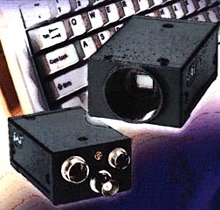Industrial CCD Camera has megapixel progressive scan.
Press Release Summary:

Compact, switchless CV-A1 has 1392 x 1040 resolution, analog output and RS232 set-up. It operates at 16 frames/sec and its software-configurable partial scan/binning capability allows rate to be increased to 124 frames/sec at reduced resolution for faster acquisition in applications where full-frame vertical resolution is not required. Camera measures 1.14 x 1.73 x 2.6 in. Reliability is calculated at 100,000 hours.
Original Press Release:
The New CV-A1, An Affordable Megapixel Progressive Scan Industrial CCD Camera, Features Small Size, Analog Output and Set-Up Via RS-232C
JAI A-S, a leading manufacturer of high-performance industrial cameras for automated imaging, introduces the CV-A1 -the latest model in its new A-series of compact "switchless" progressive scan industrial CCD cameras. A unique offering at its price point, the CV-A1 is the first A-series camera to combine a megapixel resolution (1392 x 1040) analog output with remote, "switchless" set-up capability via RS-232C interface. By utilizing proprietary technology, JAI has succeeded in designing the CV-A1 for double speed operation, making it possible for the camera's 1/2" progressive scan CCD sensor to operate at 16 frames per second. In addition, the software-configurable partial scan/binning capability allows that rate to be increased to a maximum of 124 frames/sec (at reduced resolution) for faster acquisition in applications where full-frame vertical resolution is not required. The CV-A1 offers all these features and more in a compact, low power consumption package measuring just 29mm (1.14") H x 44mm (1.73") W x 66mm (2.6") D.
Like all A-series cameras from JAI, the CV-A1 eliminates the risk of operator set-up errors since all settings are done though RS-232C instead of using DIP switches. By minimizing the use of mechanical switches, reliability has been improved to 100,000 hours calculated MTBF (mean time between failure). In addition, this allows remote configuration of the camera, an advantage in applications where cameras are deeply embedded into a system.
The CV-A1's analog interface allows several cameras to be multiplexed at the frame grabber input. The camera's frame-delay readout mode allows up to four cameras to be simultaneously triggered and read out in sequence by multiplexing the analog signal. This provides a price/performance ratio that cannot be matched by a digital solution. Other benefits of analog vs. digital include fewer restrictions of cable length and complexity, and the use of smaller diameter cable.
Other features of the CV-A1 camera include a variety of trigger modes, such as edge pre-select, pulse width control, frame-delay readout and smearless. The CV-A1 provides 12-pin Hirose connectors for power/controls, a 6-pin Hirose connection for RS-232C and a standard C-mount lens attachment.
About the JAI Group
JAI was established in 1963 in Copenhagen, Denmark, and has subsidiaries in England, Finland, Japan and USA. The JAI Group has annual sales of more than $60 million and employs 250 people worldwide. The JAI Group develops and distributes user-friendly tools for the professional international market by making electronic eyes and electronic brains work together.
The company operates within three business areas: JAI Camera Solutions manufactures and supplies cameras for the automated imaging and general imaging/surveillance markets; JAI Systems solves the most complex requirements for user-friendly optical-electronic surveillance systems; JAI Direct selects and distributes brand name video, data and telecommunications equipment.



